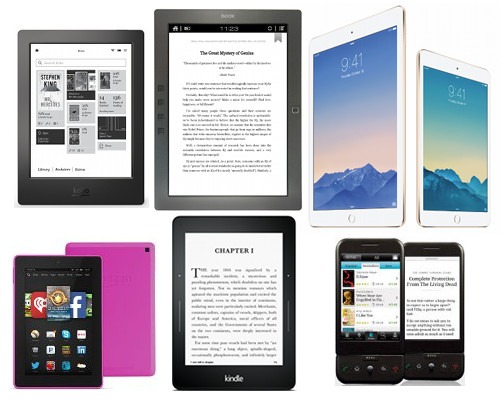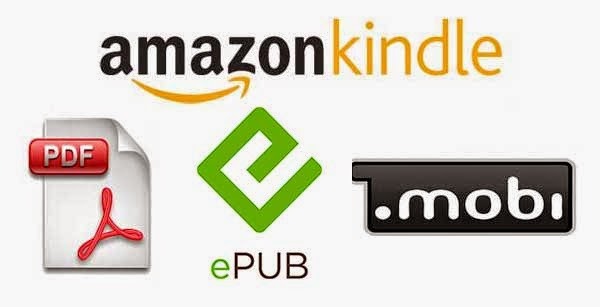Đã có nhiều người chuyển sang đọc eBook (sách điện tử) hơn so với trước đây. Chúng có mức giá rẻ hơn và cũng tiện cho việc di chuyển hơn. Chính điều này giúp nó chiếm 30% tổng số lượng sách được bán tại Mỹ.

Nhưng điều này chưa hẳn là tốt với người dùng. Không như MP3, một định dạng mà bạn có thể "quăng" vào bất cứ máy nghe nhạc nào cũng hoạt động, ebook có hàng loạt các định dạng độc quyền lẫn định dạng mở. Phức tạp hơn nữa, không phải toàn bộ các máy đọc sách điện tử đều hỗ trợ hết.
Trong bài viết này, trang MakeUseOf sẽ giới thiệu đến bạn các định dạng phổ biến, giải thích ưu điểm, nhược điểm và các máy đọc nào hỗ trợ chúng.
1. EPUB
EPUB là định dạng ebook phổ biến nhất trên thế giới. Ban đầu, nó được phát triển bởi Diễn đàn Xuất bản Số Quốc tế (International Digital Publishing Forum – một phần của World Wide Web Consortium) nhằm thay thế định dạng eBook mở cũ (OEB) vào năm 2007.
Do EPUB là một định dạng mở, sử dụng miễn phí và không có nhà cung cấp độc quyền, nó dần trở thành định dạng ebook phổ biến hơn. Thậm chí, định dạng này còn hỗ trợ các hình ảnh màu sắc, đồ họa SVG, các yếu tố tương tác hay cả video.
Chính vì thế, hầu như tất cả các máy đọc sách chính thống và hệ điều hành đều hỗ trợ định dạng này. Tuy nhiên, nhà xuất bản có thể sử dụng bất cứ hệ thống DRM nào họ muốn để "bọc" nó. Nhưng bạn vẫn có thể xóa DRM trên bất kì ebook nào mà bạn muốn.
Có một nhược điểm là những thiết bị Amazon Kindle lại chẳng thể đọc được định dạng này, ngoại trừ tablet Kindle Fire. Nếu bạn có một cuốn sách định dạng EPUB và muốn đọc nó trên Kindle, hãy sử dụng Calibre để chuyển đổi ebook sang một định dạng khác.
2. MOBI

Giống như EPUB, định dạng MOBI cũng được phát triển từ định dạng OEB cũ. Mobipocket, một công ty đến từ Pháp, đã tạo ra định dạng này vào năm 2000 và chính nó là "nền tảng" để tạo nên phần mềm Mobipocket Reader.
Amazon đã mua lại công ty này vào hồi năm 2005 và phát triển nó trong vòng 11 năm. Vào hồi tháng 10/2016, Amazon đã chính thức xóa bỏ trang web và các máy chủ của Mobipocket, nhưng định dạng MOBI vẫn còn được duy trì.
Có một vài điểm khác nhau giữa EPUB và MOBI. Cơ bản, nó không phải là định dạng mở và vì thế, nó không thường sử dụng rộng rãi. Ngoài ra, nó cũng không hỗ trợ âm thanh và video.
Định dạng này được hầu hết các máy đọc sách hỗ trợ, ngoại trừ Barnes & Noble Nook.
Lưu ý: Định dạng MOBI cũng được mở rộng với chuẩn PRC.
3. AZW và AZW3
AZW và AZW3 là 2 định dạng ebook chính thuộc quyền sở hữu của Amazon. AZW là định dạng cũ hơn, nó được giới thiệu chung với chiếc Kindle đầu tiên hồi năm 2007. AZW3 được tung ra vào năm 2011 cùng với chiếc máy đọc Kindle Fire.
Bất cứ khi nào bạn mua hay tải một ebook từ Amazon, bạn sẽ nhận được 1 trong 2 định dạng này trong thiết bị. AZW3 có nhiều lợi thế hơn so với AZW. Nó hỗ trợ nhiều kiểu, phông chữ và bố cục hơn.
Cả 2 định dạng này đều hoàn toàn tương tự như định dạng MOBI. Dù chưa bao giờ được xác nhận chính thức, nhưng rõ ràng, chúng ta có thể hiểu rằng Amazon mua lại Mobipocket nhằm sử dụng công nghệ này làm "bàn đạp" cho định dạng AZW của riêng họ. Và không như MOBI, các định dạng của Amazon hỗ trợ cả video lẫn âm thanh.
Bởi vì AZW thuộc quyền sở hữu của Amazon, thế nên, nó không được hỗ trợ rộng rãi trên những máy đọc sách như EPUB và MOBI. Và dĩ nhiên, toàn bộ các sản phẩm Kindle của Amazon có thể đọc định dạng này, nhưng các thiết bị phổ biến như máy đọc sách Nook & Kobo lại không thể.
Cả Android và iOS đều có thể đọc được AWZ, và cũng có thể đọc được trên các ứng dụng quản lý ebook phổ biến như Calibre và Alfa.
4. IBA
Một định dạng ebook độc quyền phổ biến khác mà bạn có thể gặp là IBA. Đây chính là định dạng sách được tạo từ ứng dụng iBooks Author của Apple.
Về kĩ thuật, định dạng này rất giống với EPUB. Tuy nhiên, nó dựa trên các đoạn mã widget tùy chỉnh trên ứng dụng Apple Books để hoạt động, vì thế, nó không thể đọc được trên toàn bộ máy đọc sách.
Hãy nhớ răng, định dạng này chỉ sử dụng cho những cuốn sách được viết trong iBooks Author. Nếu bạn mua những cuốn ebook bán chạy phổ biến từ cửa hàng iTunes, bạn sẽ nhận được file có định dạng EPUB, dù rằng chúng sẽ bị giới hạn DRM.
Định dạng iBook này hỗ trợ video, âm thanh, ảnh và các yếu tố mang tính tương tác.
5. PDF
Định dạng ebook phổ biến cuối cùng chính là PDF. Do định dạng này được sử dụng rộng rãi trên web, PDF dần trở thành một định dạng phổ biến cho ebook.
Nhược điểm lớn nhất của nó chính là thiếu sự tái tạo tự nhiên. Tái tạo ở đây có nghĩa là có thể điều chỉnh linh động phần hiển thị nội dung theo kích thước của màn hình hoặc cài đặt theo người dùng tùy chỉnh.
Toàn bộ các định dạng ebook chuyên dụng đều có khả năng tái tạo dựa trên trình tự của các đối tượng trong luồng nội dung. Định dạng PDF thường thiếu đi sự tái tạo phổ biến: sử dụng các thẻ tag để xác định cấu trúc cơ bản của tài liệu. Tuy nhiên, các máy đọc sách vẫn không thể hỗ trợ tốt với các file PDF đã được gắn thẻ.
Về mặt tích cực, nó là định dạng mở thứ hai trong danh sách. Năm 2008, nó đạt tiêu chuẩn ISO 32000.
Bên cạnh 5 định dạng phổ biến trên, còn có những định dạng khác ít được sử dụng hơn.
6. LRS, LRF và LRX
LRS, LRF và LRX là các định dạng ebook Broad Band. Chúng là những định dạng độc quyền do Sony tạo ra cho dòng máy đọc sách ebook của riêng mình.
LRS là chuẩn mở, nhưng LRF và LRX vẫn là đóng. Dù bất kể là gì thì Sony cũng đã từ bỏ 3 định dạng này để chuyển sang sử dụng EPUB.
7. FB2
Định dạng FB2 được dựa trên XML và ban đầu được phát triển ở Nga. Định dạng này phổ biến nhờ vào khả năng lưu trữ metadata trong chính file ebook.
Nó cũng được sử dụng như một định dạng lưu trữ do việc chuyển đổi thành các định dạng khác một cách dễ dàng.
8. DJVU
DJVU khá phổ biến trong cộng đồng khoa học. Nó có độ nén cao hơn khoảng 10 lần so với PDF. Nó cũng có thể lưu trữ hơn 100 bản quét đen trắng trong một file chưa tới 1MB.
9. LIT
LIT từng là định dạng ebook độc quyền của Microsoft. Khi kích hoạt DRM, các cuốn sách chỉ có thể đọc được trên ứng dụng Microsoft Reader.
Năm 2011, Microsoft "khai tử" định dạng LIT này.
10. RFT
Rich Text Format là một định dạng tương thích với toàn bộ các máy đọc sách có trên thị trường. Nó có lợi thế hơn TXT do khả năng giữ lại các kí tự đặc biệt và hỗ trợ cho việc tái tạo và định dạng lại văn văn bản.
EPUB, MOBI, AZW: Định dạng nào tốt nhất?

Sự thật, các định dạng mà bạn cần lo lắng chính là EPUB, MOBI và AZW.
Nếu bạn dự định "xây dựng" một thư viện ebook khá lớn trong máy tính mà có thể hỗ trợ cho hầu hết các máy đọc sách thì hãy tận dụng EPUB. Nếu bạn muốn tạo một thư viện chủ yếu dành cho Kindle thì hãy chọn MOBI. Nó không có nhiều tính năng như AZW nhưng nhiều thiết bị lại có thể đọc được nó.
Mời các bạn tham gia Group Cộng đồng VnReview để thảo luận và cập nhật tin tức công nghệ cùng cơ hội nhận quà tặng hàng tháng.
Minh Hùng